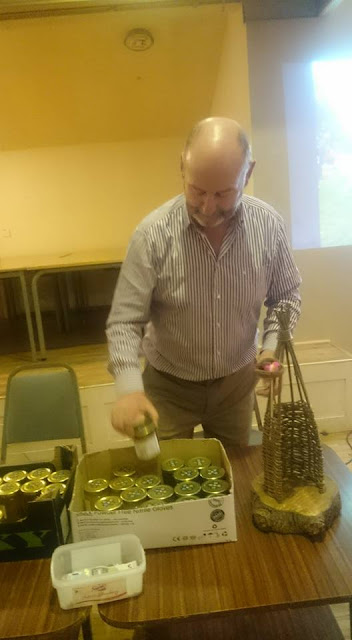I am afraid of bees, many of us are, partly because of ignorance or bad
experiences with that insect with the sting.
When the Irish Countrywomen’s Association (Castletroy Guild) invited Gerry
Ryan to give a talk on beekeeping, I was amazed at the wonder of the humble
bee. Gerry Ryan and his wife Mary run the local ‘Ryan’s Fancy’ honey enterprise
in Gortussa, Dundrum.
Every cell in the honeycomb is a perfect hexagon,
meaning all six sides are of equal length. A masterpiece in engineering. This
compact structure provides maximum storage space for honey and is more
economical because it uses less wax for holding the cells together as compared
to other shapes. Because of the perfect fit, the bees work simultaneously to
put the cells together and there is no wastage of time. Every bee is
industrious and has a unified vision.
I can’t help comparing this to a work situation
where progress is halted because someone is holding the others up. That is
terribly annoying especially in group work and far often enough there is that
one person who doesn’t quite deliver.
There are 30,000 to 60,000 bees in each of Gerry’s hives every summer. Yet
the bees do not attack each other or their own kind–
only outsiders like mice, snakes or lizards who enter their hive and pose a
threat. Sadly, humans are quite the opposite. There’s nothing that tastes
better with a cup of tea like a good gossip. I often think that these people
lead sad lives if they need to relish in talking about other people’s affairs.
It takes over a thousand bees to visit around four million
flowers in order to make a kilo of honey. This honey is not only for present
day consumption but also for their young. This reminds me of both short term
and long term planning. One aspect of Asian culture which is like bee culture
is that we learn the importance of saving from a young age. I am most surprised
to hear that many young people here do not have savings and even if they have, it
is short term saving to buy something. Maybe in a welfare state, the idea of
saving is eclipsed by the expectation of handouts. With Christmas just over and children having received cash from doting relatives, I wonder if any child
will put away some of it in the post office or bank?
It is interesting to note that flowers are colourful so that
bees are attracted to them for their nectar and in turn their pollen will be
distributed. Imagine a world without the need for pollination by bees. Then
flowers do not have to be colourful and we will be living on a drab and grey
earth instead!
Adaptation is key in the life of a bee. Bees communicate very well,
using vibrations and pheromones. I think it is extremely important to belong to
a community, to learn the culture and to be part of it. In almost all of the
community and interest groups that I am in, I can safely say that I am the only
Malaysian.
I am constantly surrounded by pockets of people who originated from
other countries but now call Ireland their home - be they immigrants, refugees,
students or working professionals - moving in their own little circles. It is of course more convenient to huddle
with people from the same country and speak in your native tongue, but we
actually learn much more and become better people when we immerse ourselves in
the lives of others who are not like us.
Beekeeping calls for respect and interdependency. I often wonder if man
is robbing the bees of their honey, what will the bees and their brood feed on?
Because bee keepers provide the bees
with a well protected home, the bees produce more honey than they need. This
respect for nature seems to be lacking in so many human endeavours like
indiscriminate tree felling or deep sea fishing.
The Federation of Irish Beekeepers’ Associations runs a one week summer
course in Gormanston College for all levels of experience. However, many local
associations also have beginners’ courses over the winter.
Beekeeping is an ancient craft and I am tempted to don that white bee
keeper’s suit and add it to my list of hobbies.
But first I must overcome my fear of busy bees buzzing.
This article was originally printed in THE NEW STRAITS TIMES MALAYSIA 22 JANUARY 2017
http://digital.nstp.com.my/nst/books/nstnews/2017/20170122nstnews/index.html#/23/




No comments:
Post a Comment